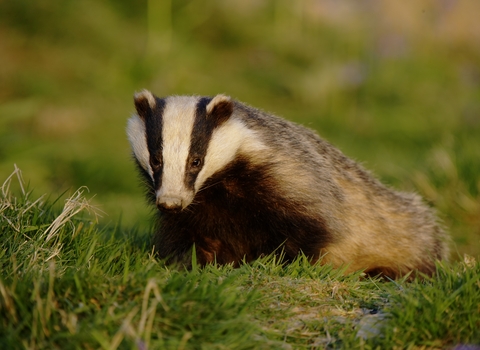
©Mark Davison
European badger
Scientific name
Meles melesWhen to see
January to DecemberSpecies information
Category
Statistics
Length: 75-100cmTail: 15cm
Weight: 8-12kg
Average lifespan: 5-8 years
About
The black-and-white striped badger is a well-known species in the UK. It is our largest land predator feeding on small mammals, birds’ eggs, worms, fruit and plants. Badgers live in large family groups in burrows under the ground called a ‘sett’. You know if a sett is lived in as it is usually neat and tidy with clean doorways marked with piles of used bedding made up of dry grass and leaves. There will also be a particularly smelly pit nearby that the badgers use as a toilet! They have strong front paws, which they use to dig for food. Cubs are born in January or February but spend the first few months underground only coming out in spring when it is a little warmer.How to identify
An unmistakable animal, the badger is large and grey, with a short, fluffy tail, black belly and paws, and a black-and-white striped face.Distribution
Found throughout England, Wales, Scotland (except for the far north) and Northern Ireland. Absent from Scottish islands, the Isle of Man, the Isles of Scilly and the Channel Islands.In our area
Badgers are surprisingly widespread around London's outer suburbs, and in some parts they're even common. They are increasingly being spotted in cemeteries and allotments, on waste ground, in back gardens and on railway edges. Brockley in south east London is the one locality name that actually references badgers - 'brocc' being the Old English name given to badgers.
Studies have discovered interesting differences between urban badgers and their rural relatives. City badgers tend to have smaller family groups comprising five or six individuals (compared to an average of 30 in rural locations). They live in much smaller areas with fewer 'satellite' or outlying setts, perhaps because there's less space available in London. Badgers living in urban environments are also slightly larger than their country cousins.
Did you know?
Badgers can eat several hundred earthworms a night! If food is in short supply, badgers will forage during the day, as well as at night. If there are badgers nearby, you can tempt them into your garden by leaving unsalted peanuts out - a tasty snack for our striped friends.Watch
Badger (https://vimeo.com/642276006)
Russell Savory
Badgers and bovine tuberculosis
Bovine tuberculosis is a highly infectious disease of cattle, which has devastating impacts on farming businesses every year. Badgers can also become infected with bovine tuberculosis, although is it not a major cause of death for them. The risk of infection is very low for the vast majority of the human population (see UK Government advice here).
Due to the economic burden placed on the taxpayer and farming industry through bovine tuberculosis in cattle, the UK Government has supported a badger cull as a mechanism to control the disease. The Wildlife Trusts firmly believe that this is not the answer and that the scientific evidence demonstrates that culling could even risk making the situation worse.
You can find out more about the badger cull and The Wildlife Trusts' position here.
Badgers are surprisingly widespread around London's outer suburbs, and in some parts they're even common. They are increasingly being spotted in cemeteries and allotments, on waste ground, in back gardens and on railway edges. Brockley in south east London is the one locality name that actually references badgers - 'brocc' being the Old English name given to badgers.
Studies have discovered interesting differences between urban badgers and their rural relatives. City badgers tend to have smaller family groups comprising five or six individuals (compared to an average of 30 in rural locations). They live in much smaller areas with fewer 'satellite' or outlying setts, perhaps because there's less space available in London. Badgers living in urban environments are also slightly larger than their country cousins.
